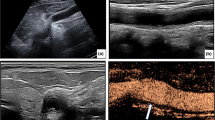Abstract
Takayasu’s arteritis (TA) is a rare vasculitis that affects the aorta and its primary branches. Heterogeneous clinical manifestations have been described in different geographical areas. We aimed to evaluate demographic, clinical, and angiographic features and the outcome in 16 TA patients who were followed in a single center in Serbia. TA was diagnosed according to the 1990 American College of Rheumatology criteria with median delay of 2 years. The majority of patients (81%) experienced one or more disease relapses and long-term remission was achieved in 94%. Five-year survival rate was 94%. Common systemic manifestations at disease onset included fever (69%), arthralgia (25%), weight loss (19%) and vascular symptoms, arm claudication (100%), headaches (69%), dizziness (56%), and hypertension (37%). All patients had multiple arterial bruits with diminished/absent left arm pulse in 88%. The raised erythrocyte sedimentation rate and C-reactive protein levels were found in 63% and 80%, respectively. Angiography revealed stenotic or occlusive sites of multiple arterial involvement. Stenosis of the left subclavian artery was the most frequent lesion (88%). The angiographic classification was as follows, 50% type I, 19% type IIa, and 31% type V arteritis, suggesting relatively favorable vascular lesions and infrequent serious complications. Glucocorticoids were the main initial therapy for active disease; however, treatment with additional immunosuppressive agents was required in two-thirds of the patients. Seven patients (44%) underwent one or multiple surgical interventions. The main indications for surgery were cerebral hypoperfusion, severe limb claudication, and gangrenous infection. The demographic and angiographic disease patterns in our cohort were similar to American, Italian, Japanese, and Korean cohorts in terms of frequent involvement of the branches of aortic arch and differed from cohorts from other Asian countries in which abdominal aorta and renal artery involvement prevailed.



Similar content being viewed by others
References
Valante R, Hall S, O’Duffy J (1997) Vasculitis syndrome. In: Kippel JH (ed) Primer on the Rheumatic Diseases, 11 edn. Atlanta, GA, 23:1079–80
Keystone E (1998) Takayasu’s arteritis. In: Kippel JH, Dieppe PA (eds) Rheumatology, 2nd edn. Mosby, London, pp 25.1–25.4
Fraga A, Medina F (2002) Takayasu’s arteritis. Curr Rheumatol Rep 4(1):30–38
Ueda H (1968) Clinical and pathological studies of aortitis syndrome: committee report. Jpn Heart J 9:76–87
Andrews J, Mason JC (2007) Takayasu’s arteritis—recent advances in imaging offer promise. Rheumatology 46:6–15
Numano F, Okawara M, Inomata H et al (2000) Takayasu’s arteritis. Lancet 356:1023–1025
Tada Y, Sato O, Ohshima A et al (1992) Surgical treatment of Takayasu’s arteritis. Heart Vessels Suppl 7:159–167
Arend WP, Michel BA, Bloch DA et al (1990) The American College of Rheumatology 1990 criteria for the classification of Takayasu arteritis. Arthritis Rheum 33:1129–1134
Hata A, Noda M, Moriwaki R et al (1996) Angiographic findings of Takayasu arteritis: new classification. Int J Cardiol 54(Suppl):S155–163
Hoffman GS (1996) Takayasu arteritis: lessons from the American National Institutes of Health experience. Int J Cardiol 54(Suppl):S83–S86
Hoffman GS, Ahmed AE (1998) Surrogate markers of disease activity in patients with Takayasu arteritis: a preliminary report from The International Network for the Study of the Systemic Vasculitides (INSSYS). Int J Cardiol 66(Suppl):S191–S194
Kerr GS, Hallahan CW, Giordano J et al (1994) Takayasu arteritis. Ann Int Med 120:919–929
Quemeneur T, Hachulla E, Lambert M et al (2006) Takayasu arteritis. Presse Med 25(5Pt2):847–856
Vanoli M, Bacchiani G, Origgi L et al (2001) Takayasu’s arteritis: a changing disease. J Nephrol 14:497–505
Anton E (2005) Large vessel arteritis: a diagnostic challenge in the elderly. J Clin Pathol 58:782–784
Waern AU, Andersson P, Hemmingsson A (1983) Takayasu’s arteritis: a hospital-region based study on occurrence, treatment and prognosis. Angiology 34(5):311–320
Ischikawa K (1988) Diagnostic approach and proposed criteria for the clinical diagnosis of Takayasu’s arteriopathy. J Am Coll Cardiol 12:964–972
Hall S, Barr W, Lie JT et al (1985) Takayasu arteritis: a study of 32 North American patients. Medicine 64(2):89–99
Lupi-Herrera E, Sanches-Torres G, Marcushamer J et al (1977) Takayasu arteritis. Clinical study of 107 cases. Am Heart J 93:94–103
Maksimowicz-McKinnon K, Clark TM, Hoffman GS (2007) Limitations of therapy and a guarded prognosis in an American cohort of Takayasu arteritis patients. Arthritis Rheum 56(3):1000–1009
Ishikawa K, Maetani S (1994) Long-term outcome for 120 Japanese patients with Takayasu’s disease. Clinical and statistical analyses of related prognostic factors. Circulation 90:1855–1860
Park M-C, Lee S-W, Park Y-B et al (2005) Clinical characteristics and outcomes of Takayasu’s arteritis: analysis of 108 patients using standardized criteria for diagnosis, activity assessment, and angiographic classification. Scand J Rheumatol 34:284–292
The ITAKA Study Group Vanoli M, Daina E, Salvarani C et al (2005) Takayasu’s arteritis: a study of 104 Italian patients. Arthritis Rheum 53(1):100–107
Ureten K, Öztürk MA, Onat MA et al (2004) Takayasu’s arteritis: results of a university hospital of 45 patients in Turkey. Int J Cardiol 96:259–264
Sato EI, Hatta FS, Levy-Neto M, Fernandes S (1998) Demographic, clinical, and angiographic data of patients with Takayasu arteritis in Brazil. Int J Cardiol 66(Suppl):S67–S70
Zheng D, Fan D, Liu L (1992) Takayasu arteritis in China: a report of 530 cases. Heart Vessels 7(Suppl):S32–S36
Suwanwela N, Piyachon C (1996) Takayasu arteritis in Thailand: clinical and imaging features. Int J Cardiol 54(Suppl):S117–S134
Jain S, Kumari S, Ganguly NK et al (1996) Current status of Takayasu arteritis in India. Int J Cardiol 54(Suppl):S111–S116
Petrović-Rackov Lj, Mitrović D (2003) Takayasu arteritis. In: Mitrović D, Anđelković Z, Glišić B (eds) Zapaljenske bolesti krvnih sudova, Beograd, pp 280–294
Hoffman GS (1995) Treatment of resistant Takayasu’s arteritis. Rheum Dis Clin North Am 21:73–80
Giordano JM (2000) Surgical treatment of Takayasu’s arteritis. J Cardiol 75(Suppl):S123–S128
Miyata T, Sato O, Koyama H et al (2003) Long-term survival after surgical treatment of patients with Takayasu’s arteritis. Circulation 108:1474–1480
Joh JH, Kim DK, Park KH et al (2006) Surgical management of Takayasu’s arteritis. J Korean Med Sci 21(1):20–22
Disclosures
None.
Author information
Authors and Affiliations
Corresponding author
Rights and permissions
About this article
Cite this article
Petrovic-Rackov, L., Pejnovic, N., Jevtic, M. et al. Longitudinal study of 16 patients with Takayasu’s arteritis: clinical features and therapeutic management. Clin Rheumatol 28, 179–185 (2009). https://doi.org/10.1007/s10067-008-1009-7
Received:
Revised:
Accepted:
Published:
Issue Date:
DOI: https://doi.org/10.1007/s10067-008-1009-7



